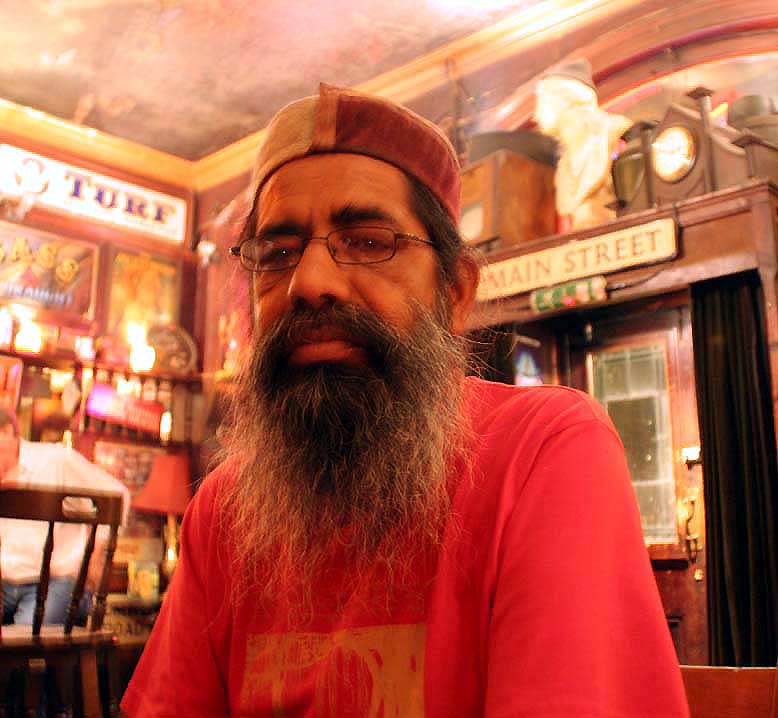 |
Bhaskar Bhattacharyya
A charismatic guide to the
mysteries of India for television audiences in Britain

Photo by Colin Cookson
Kevin Rushby
Monday February 27, 2006
The Guardian
The bearded face and warm personality of Bhaskar Bhattacharyya became known to millions of television viewers in Britain during the coverage of the 2001 Kumbh Mela, a Hindu festival of epic proportions celebrated on the banks of the river Ganges at Allahabad, in Uttar Pradesh, India. Bhaskar, who has drowned at the age of 55, was a documentary filmmaker and scholar of Indian spiritual culture. For those who knew him, he was also a supreme party guru - a man who collected people and connected them with each other - and an infectious chuckler. One German friend accurately described him as a lebenskünstler, a person whose life is their art.
Bhaskar was born in Darjeeling to a Bengali family that had already spread itself across the cultural range from tantric mysticism to Marxism. The family home was in Calcutta, but in 1955 his schoolteacher parents, Ramendranath and Mira Bhattacharyya, took a chance on a new life in Uganda, where they stayed for 11 years, leaving for London as the political situation began to deteriorate.
The young Bhaskar, bespectacled and rather intense, looked like a young Rabindranath Tagore, but his cultural references rapidly widened as he became a fanatical blues fan and frequenter of squats on Haverstock Hill, north London. Like many others at that time, he was feeling the pull of alternative lifestyles over more orthodox pursuits. In 1971 he dropped out of a physics degree at City University and travelled to India, where he developed his characteristic ability to surround himself with life and colour, immersing himself in esoteric practices yet always retaining his impish good humour.
After five years of "perfecting his beard, but not his Sanskrit", as his younger brother Ranjan put it, Bhaskar went to study the Baul musicians, a band of tantric mystics, many of whom became his lifelong friends. From this period came a collaboration with the filmmaker George Lunneau and entry into a career as director, producer and India expert for the UK television industry. He formed the production company Maya Vision with Gerry Troyna and Becky Dodds. Already blessed with great charisma, he soon revealed he had a rare talent for celluloid - not in practical terms, he never learned how to operate a camera - but in the indefinable art of bringing the right people and places together. He worked as India adviser on such acclaimed television series as The Jewel in the Crown (1984) and Great Railway Journeys of the World (1989).
Bhaskar's wedding in 1988 showed just how adept he had become at navigating the radically different elements of his life: east and west, bohemian and brahmin. Hiring two hotels at Manali, in the Himalayas, one for each group, he kept everyone happy, steering guests either towards the smoky campfire revelries or the more traditional steaming pots of chai and sandesh. He and his wife settled in Delhi, where their house became a vibrant melting pot of talents, conversation, music and laughter.
As director of programmes for the Business India television channel, Bhaskar created a generation of young filmmakers, sometimes with alarming speed - one young protege bumped into him in the Press Club bar in Delhi and a week later was watching his first documentary go out on air. It was Bhaskar's gift for friendship that carried him through, opening doors in the salons of New Delhi and London, but also with the poor and downtrodden.
On one occasion, he arranged to film a group of Naxalite rebels planning a terrorist attack; on another, finding the budget underspent, he simply handed out the remainder to needy villagers. Travelling with Bhaskar on these shoots was an education and an entertainment; his culture and learning were deep, but worn lightly. His stock-in-trade had become the hidden diversity of India - minstrels, Gypsy rovers, shamans and saddhus - but his skills in video production led to other opportunities, often musical. He worked with Itzhak Perlman and, in 1983, with David Bowie on his Serious Moonlight tour.
Despite these experiences in the wider world, it was always the Bauls who were Bhaskar's first love, and he never forgot the debt he owed them. In 1993 he collaborated with Nik Douglas on the book The Path of the Mystic Lover, a collection of 84 Baul lyrics which became something of a cult classic in new age circles.
Bhaskar's television career reached a new peak with the Kumbh Mela. He helped set up a luxury tented camp for foreign visitors, and guided them through the festival. Typically, a week after that he had disappeared from the media spotlight and could be found, living in total simplicity at his old haunt at the Assi Ghat, on the banks of the Ganges in Varanasi (Benares), almost indistinguishable from all the other bearded holy men. The last couple of years of his life were spent largely in London, looking after his ageing parents. It was on a film shoot in Tamil Nadu for Channel 4 that he tragically drowned, caught in a rip tide off a beach near Chennai.
His wife Rohini Pathania and his son Abhinava survive him.
ˇ Bhaskar Bhattacharyya, television producer, born June 4 1950; died February 10 2006